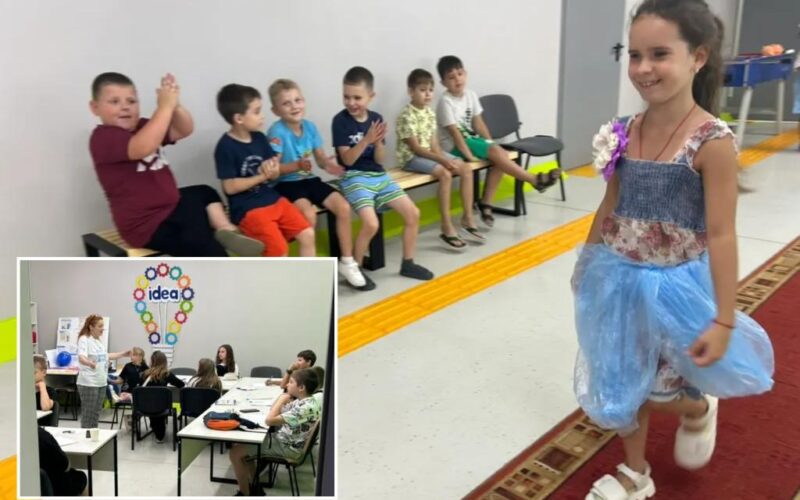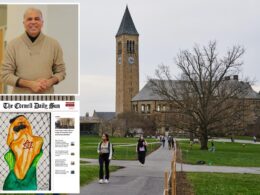KHARKIV, Ukraine — Thousands of children across Ukraine have been stuck behind computer screens for more than five years as Russia’s constant bombings have left them unsafe to leave COVID-era online schools the rest of the world discarded years ago.
Moscow routinely targets civilian infrastructure all over Ukraine, making even the most basic activities an intolerable risk.
Fourth-grader Kyrylo has only attended classes in person for three months out of his entire life. The little boy started kindergarten in 2020, as the pandemic forced students across the world into virtual homeschooling.
When schools reopened in the fall of 2021, Kyrylo was delighted to meet friends in first grade and learn critical social skills — but Russia launched its full-scale war on Ukraine the following February, forcing kids back online.
“It’s very scary, because I have to think about my son’s life. He’s only 10 years old and I cannot just let him go and hang out outside on his own,” his mother, Vlada, a part-time tram driver, told The Post. (The parents who agreed to be interviewed asked to be identified by first names only to protect their children from Russian targeting.)
“We struggle with school classes because they are conducted online and teachers are not able to reach all of them. I have to re-teach him what he’s learned.”
Kyrylo has one real friend — the son of his next-door neighbor. It’s hard to meet other children his age when he has to stay home all day before joining his mother on her nightly route so they can be assured of making it to a shelter if and when air raid alarms go off.
“It’s like never-ending COVID times,” Vlada said. “But this time, with bombs.”
As in the US, most schools in Ukraine are not equipped with bomb shelters. That means parents often have to make steep sacrifices to ensure their kids get the educations they need, as safely as possible.
Some try to scrape together enough funds to send their children to expensive private schools, which do have shelters.
“I have to work long hours to give him a proper education now,” said Kharkiv resident Slava, a pharmacist, of her 10-year-old son.
“The first year [of the war], he was alone online and it was difficult, so now I decided I want to give him something — a real, normal education.”
Slava’s son had become “depressed” studying home alone, she said — but he’s thriving after being back in the classroom.
“He likes to be with kids, not to learn online because it’s difficult,” Slava explained. “Small kids can’t understand teachers on a screen, so you need communication with other kids.
“As I understand, it’s not the aim of school to study only, but to communicate and have friends.”
Other parents, such as Tatiana, sacrifice time with their children to ensure their kids are safe from Moscow’s brutal attacks.
Tatiana’s 7-year-old son Alexei struggled studying online for the first two years of the war. Fearing her child would be left behind, Tatiana made the heart-wrenching decision to move him into her mother’s house hours away in Poltava, a smaller town further from the Russian border whose public school has a shelter.
“We are trying our best to make life good for our child,” Tatiana said. “I can travel to Poltava and see them and come back — we’re trying to make it work.
“In Poltava, all schools are working offline, but the children go down to the shelter every time [there’s an air-raid alarm]. It’s very strict.”
A very lucky few, however, are able to attend schools built underground thanks to generous donors from across the world. The Post toured one such facility in Pisochyn, a small suburb of Kharkiv, that will welcome students for its first full school year later this month.
The school — whose name The Post is not using for fear of Russian targeting — is decorated in bright, happy colors to bring some light to the windowless facility three stories below ground.
In total, 250 students can fill eight classrooms — but they must come in two four-hour shifts each day due to the lack of space and overwhelming demand, according to Pisochyn mayor Oleg Chernobai.
On the day The Post toured the school, it was hosting a summer program for students who had only previously studied online to “catch them up” to where they need to be.
With the school just 15 miles from the Russian border, Chernobai said it takes just “45 seconds for a Russian rocket to reach Kharkiv,” meaning holding class underground is the safest option available — and outdoor recess is out of the question.
”Even if there is no alarm, they are already underground,” the mayor said. “This way, they do not have to go outside when a missile is incoming. They can continue their studies.”
One student, a 6th grader named Anastasiia, said she felt “safer at school than I do at home.”
Another girl, named Yevheniia, said the best thing is being around the friends she missed dearly when she was stuck online learning.
”I do like coming here, coming in-person because we have our friends and teachers, we do tests and handcrafts,” she said. “It’s much better than staying at home.”
”If we have to be in war, we should at least have friends.”








